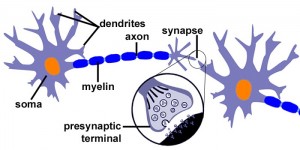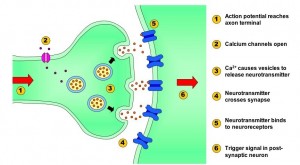Origins of Communication

The beauty of teaching Science is the more you learn, the more there is to wonder. The challenge of teaching Science is making content accessible when so much is unobservable.
The well-known saying ‘communication is the key to success’ is highly relevant when teaching VCE Biology. The subject focuses on cell to cell communication including the role of neurotransmitters – the chemical messengers of the body – to coordinate muscle and gland responses.
The role of a Science teacher is much like that of a neurotransmitter, a messenger organising and communicating information in a sequenced, organised and pertinent manner.
VCE Biology is a modern and relevant subject that brings science to life for students when explained through familiar contexts. To facilitate student understanding in VCE Biology at St Catherine’s School a variety of strategies are undertaken, including:
- the use of analogies to bring real life understanding to complex concepts. For example, how molecules cause cellular responses can be compared to a party invitation arriving by mail and the chain of activities that it triggers or how enzyme concentration can affect the rate of reaction is comparable to the number of turnstiles available at the Melbourne Cricket Ground.
- exploring the complexity of protein structures through the tactile use of pipe cleaners
- the use of lollies to model biological molecules
- animations to bring microscopic concepts to life
Creating meaningful connections to the Biology curriculum for students ensures they have more confidence and success in their biological general knowledge. Everyday examples clarify and extend scientific concepts and assist them to feel comfortable in applying their knowledge to new situations, something which is particularly helpful when under examination conditions. My hope is that the foundation is set for students to continue to learn and wonder.
Interested in learning more? Find out what alcohol, Botox and biological warfare have in common below!
What do alcohol, ICE, Botox and biological warfare all have in common?
Neurotransmitters!
 Neurotransmitters are how nerve cells communicate with each other.
Neurotransmitters are how nerve cells communicate with each other.
Nerve cells communicate with other nerve cells using electrical impulses along the nerve fibres (axons) to the synapse. This is followed by a chemical component, the neurotransmitter, to transmit the nerve impulse across the synapse (the gap between two nerve cells) to the next nerve cell or muscle cell.
There are two main classes of neurotransmitters. Excitatory and inhibitory.
One common example of an excitatory neurotransmitter is acetylcholine. These transmitters cause an electrical impulse to occur in the next cell (usually a muscle). The students have learnt that there must be specific complementary shaped receptors for the neurotransmitter on the next cell as well as a critical concentration of the neurotransmitter. This allows positively charged ions enter for the next neuron to respond with an electrical impulse.
Not all neurotransmitters are excitatory. Inhibitory neurotransmitters prevent the next cell from responding. One inhibitory neurotransmitter is called GABA. When it attaches to its receptor in the post synaptic membrane, chloride ions with a negative charge enter the post synaptic neuron. This makes the firing of another electrical impulse less likely.
These excitatory and inhibitory neurotransmitters work together to allow fine coordination of our nervous system that we can take for granted.
What we put into our bodies can affect this fine coordination.
- Alcohol (ethanol) binds to the GABA receptors and the chloride ions continue to enter for longer. It also increases the amount of GABA, an inhibitory neurotransmitter, released from the presynaptic neuron therefore the neurons are less likely to fire, explaining some of the sedative effects of alcohol. Ethanol also reduces the effect of an excitatory neurotransmitter which is an important chemical for learning and memory which may explain some memory loss associated with drinking.
- Botox is the trade name of a drug based on the botulism toxin.When locally injected in small amounts, it is used to treat severe muscle spasms or uncontrollable sweating, and can be used for cosmetic purposes. This is because Botox blocks the release of the neurotransmitter acetylcholine, interfering with a muscle’s ability to contract.
- Sarin (the nerve gas used in the Tokyo subway in 1995 and in Syria in 2013) interferes with the breakdown of the neurotransmitter acetylcholine at the post synaptic membrane. The neurotransmitter does not get broken down in the synapse as it should. Acetylcholine accumulates which causes a lack of control, particularly of the muscles associated with breathing and death results.






